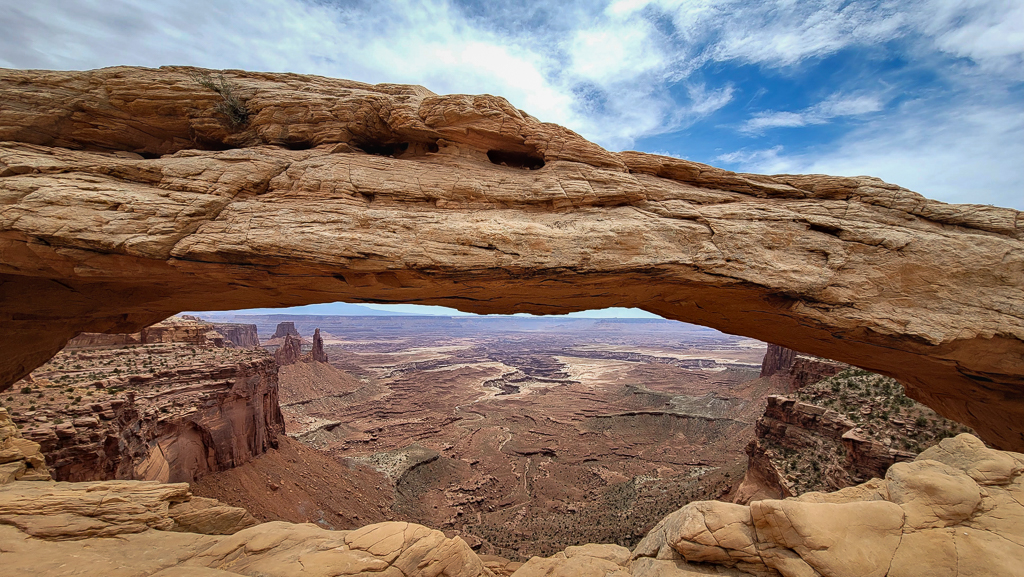
Last month, my sister Marie (aka Mimi) and her husband Mike came to visit, specifically for an adventure with us to Moab, Utah. We packed a lot into the short few days, and had so much fun on the journey with them.




On the drive up, we stopped at the Four Corners Monument, the only place in the United States where four states meet in one location. Being able to step in four different states at the same time is certainly not an everyday experience, yet you can do exactly that here at the intersection of Colorado, Utah, New Mexico and Arizona. The geographical conjunction is very remote and marks the boundary between two Native American governments: the Navajo Nation, which maintains the monument, and the Ute Mountain Ute Tribe.


After that, we were on the hunt for a place to stop and have a picnic lunch — someplace out of the ferocious winds. Nearly an hour later, we found ourselves in Bluff, Utah, at the Bluff Fort Historic Site that commemorates the original pioneer town founded by Mormon missionaries in 1880. We found a spot out of the wind on the porch of an old cabin in the fort, and proceeded to have lunch, all while watching a video courtesy of the staff who insisted on sharing with us the history of these Mormon missionaries. It looked like it was going to be a long video, so we ate quickly and high-tailed it out of there!



In Moab we stayed three nights at The Gonzo Inn, a boutique hotel in town within easy walking to restaurants and just a short drive to Arches National Park. Our rooms faced the back of the property near trees and a creek, and importantly away from the traffic noise of town. We loved the cafe on site, Cafe Italiano, for quick breakfasts before starting our days. And of course, we had our own little happy hours back at the hotel every night.
Arches National Park was our main agenda, and as always, this park never disappoints. We spent most of our first day seeing the view points and overlooks, and worked in some of the smaller hikes. We didn’t have time to hike to Delicate Arch, the park’s most famous arch, but did see it from a distant overlook. By the way, all of the photos from this blog are from cell phones, many of which were taken by Mimi.





The desert was abloom with spring wildflowers and its own unique plant life.









When visiting Moab, we always include a trip to Dead Horse Point State Park, just 32 miles from town. While Arches and Canyonlands National Parks get all the attention, the views from Dead Horse Point will blow you away. To us, this is quite possibly the most spectacular viewpoint in all of the Southwest. Towering 2,000 feet above a bend in the Colorado River, the overlook provides a breathtaking panorama of Canyonlands’ sculpted pinnacles and buttes. Millions of years of geologic activity created the spectacular views. Best of all, the park is less crowded than the nearby national parks, and the bathrooms are nicer!

Our afternoon at the Island in the Sky section of Canyonlands National Park was yet again a very windy day. We were nearly sand-blasted out at Mesa Arch, but patiently waited our turn to get photos in front of the famous arch. Mimi and I witnessed a guy climb on top of the arch so his buddy could takes pictures. That’s illegal and dangerous. Everyone in the vicinity (including us) started yelling at the tourist to get off the arch, which he did pretty quickly. I don’t think he expected everyone to have such a strong and immediate reaction. Idiots!

We walked around the Green River Overlook, another spectacular view point. With the high winds, no one ventured too near the edges.
We found a place to picnic for a late lunch, and then headed back to Moab for a drive along the gorge of the Colorado River to Castle Valley and Fisher Towers, home to some truly classic Western views (lots of western movies have been filmed in the area).



One last stop on the day we headed home was at Newspaper Rock in Bears Ears National Monument In Utah. One of the West’s most famous rock art sites, Native American Indians have been engraving and drawing on this rock called “Tse’ Hane” in Navajo, or “rock that tells a story,” for more than 2,000 years. The markings tell of stories, hunting patterns, crop cycles and depict animals, human figures and various symbols, some thought to be religious in nature. These petroglyphs were produced by pecking through the black desert varnish found on the rock to the lighter rock beneath. One can only guess at the intended meaning of these drawings, but we’re glad they’ve been preserved for us to ponder.












































Jennifer Comeau | 16th Jun 22
Wow! Fantastic, Rozanne and Todd. I hope to travel that way this autumn. Your post feels like my own personal travel guide to these special places. I love the insider’s view!
Marie Smith Cary | 17th Jun 22
You guys made it a trip of a lifetime! Such fun and so many awe-inspiring gorgeous views. Just amazing!
Jeff and Rose Gardiner | 17th Jun 22
Wonderful Photos! We miss our lunch get-togethers. Let us know if you received our email?
Lonna | 17th Jun 22
As usual, stunning photos! Looks like a wonderful trip with your sister and hubby!
Beth Cary | 18th Jun 22
Wow, the pictures are phenomenal and I loved the narration. Definitely would put this on a bucket list, but I think we’re running out of time. So glad y’all had such a great time and created these fantastic memories!
Don | 20th Jun 22
As always Todd & Roseanne, your travels excite a feeling of adventure and fun.
Thanks for sharing